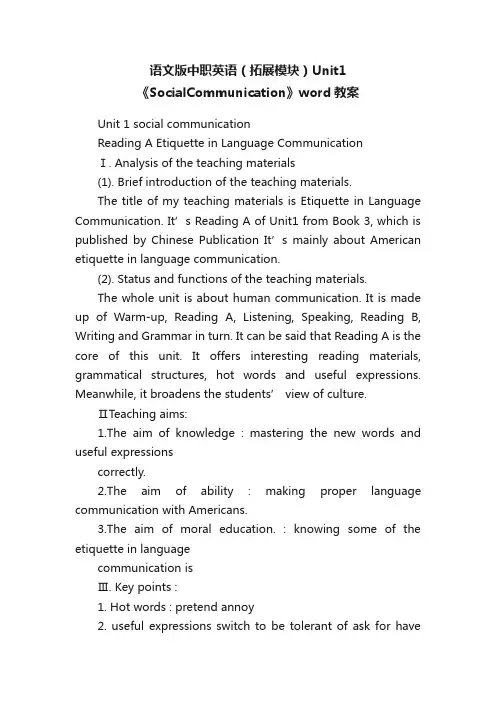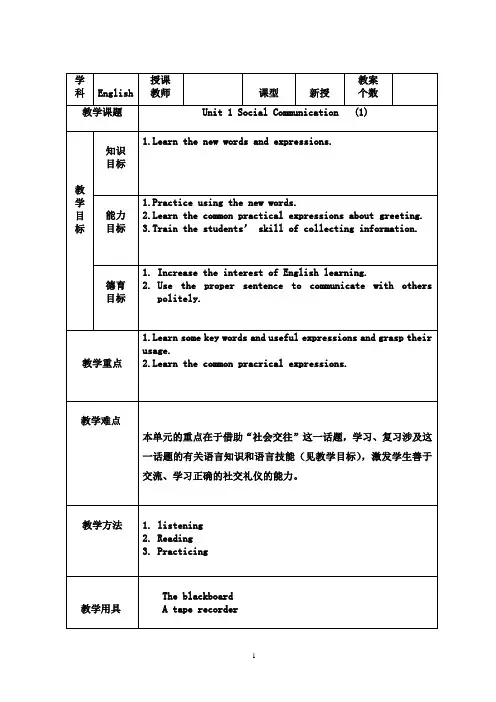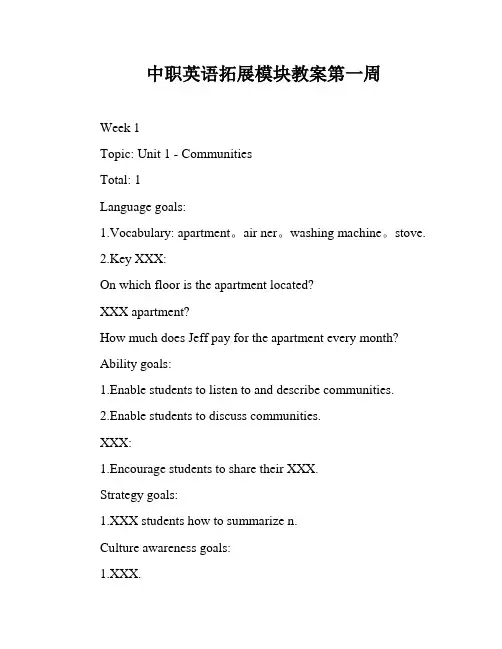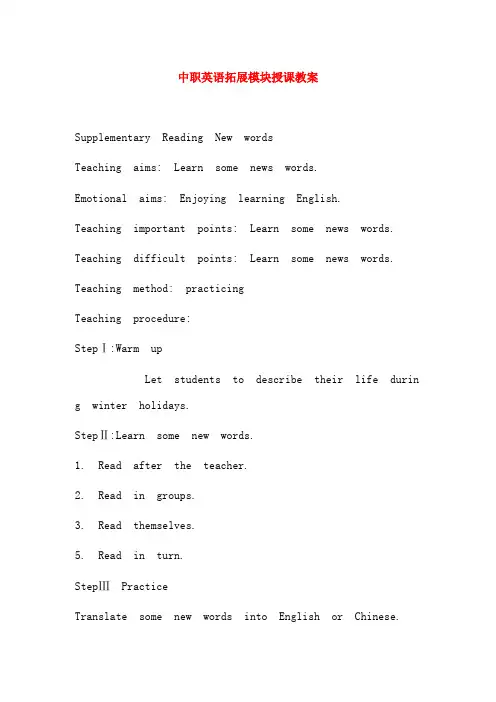中职英语拓展模块教案第一周
语文版中职英语(拓展模块)Unit1《SocialCommunication》word教案

语文版中职英语(拓展模块)Unit1《SocialCommunication》word教案Unit 1 social communicationReading A Etiquette in Language CommunicationⅠ. Analysis of the teaching materials(1). Brief introduction of the teaching materials.The title of my teaching materials is Etiquette in Language Communication. It’s Reading A of Unit1 from Book 3, which is published by Chinese Publication It’s mainly about American etiquette in language communication.(2). Status and functions of the teaching materials.The whole unit is about human communication. It is made up of Warm-up, Reading A, Listening, Speaking, Reading B, Writing and Grammar in turn. It can be said that Reading A is the core of this unit. It offers interesting reading materials, grammatical structures, hot words and useful expressions. Meanwhile, it broadens the students’ view of culture.ⅡTeaching aims:1.The aim of knowledge : mastering the new words and useful expressionscorrectly.2.The aim of ability : making proper language communication with Americans.3.The aim of moral education. : knowing some of the etiquette in languagecommunication isⅢ. Key points :1. Hot words : pretend annoy2. useful expressions switch to be tolerant of ask for havetrouble (in)doing/with sth. Leave out now that3. etiquette in language communicationⅣ: Difficult points:mastering the hot words and useful expressions and putting the knowledge of etiquette in language communication into reality.Ⅴ:Conditions of the students.The students of our vocational high school are poor in fundamental English comparatively. As a result, most of them have much less interest in learning English. But they are active in taking part in activities. Their destination of studying English is to develop necessary abilities needed in their work and lives.ⅥTeaching and learning methods.1. Teaching methods:elicitation method, encouraging method, explaining method and situational method.2. learning methods :3. exploring, participating and practicing methodsⅦ: Teaching Design:carry on this lesson in six steps: lead-in, fast reading, intensive reading, practice, summary and homework, which take 2 minutes, 5 minutes, 20 minutes, 15 minutes, 2 minutes and 1 minutes respectively. Before I end this pa rt, I’d like to display my design of writing on the blackboard.ⅧTeaching procedure:Step 1 Lead in (2’)Tell a story , showing some pictures with wrong manners → Find mistakesThen ask the question: “What are wrong manners?”The students needn ’t answer t he question Step 2 fastreading (5)read fast → showing the pictures again → give their answers Then ask the question: “What we should say/do here?”× ① ×② × ③ ×④Step 3 Intensive reading (20)1. read carefully ,then ask the question: “Why should we beha ve so?”2. key words and useful expressions → long sentences → expansionKey words and expressions:ok ① ok②①② ?④ ?③③ ok ③ ok④In this step, I’ll take three steps to present the key words and useful expressions. First, the usage. Then, show one or two model sentences. Last, to get the students to participate and practise, give them one or two sentences as exercises. The exercises can be in different forms, such as, filling in blanks, translating, correcting mistakes, and so on. All the exercises are done by the students themselves.be tolerant of/towards:Usage: be tolerant of/towards +n./ pron .Model sentences:1.Mr. Smith is not very tolerant of/towards others .2.We should always be tolerant of the views of others even if we disagree with them. Exercises:1.Fill in the blank with the right form of the given words:Her own mistakes made her very____( tolerant) of/towards others.Have some/no trouble(in)…Usage: have some/no trouble(in) doing sth.Model sentences:I had some trouble (in) reading the letter . His handwriting is very bad.They had no difficulty in understanding what he said.Exercises:Translate the Chinese sentence into English:他们毫不费力就找到了我的家。
职专英语教案拓展模块1-1

1.Learn some key words and useful expressions and grasp their usage.
2.Learn the common pracrical expressions.
教学难点
本单元的重点在于借助“社会交往”这一话题,学习、复习涉及这一话题的有关语言知识和语言技能(见教学目标),激发学生善于交流、学习正确的社交礼仪的能力。
学科
English
授课
教师
课型
新授
教案
个数
教学课题
Unit1 Social Communication(1)
教
学
目
标
知识
目标
1.Learnthenew words and expressions.
能力
目标
1.Practice using the new words.
2.Learn the common practical expressions aboutgreeting.
教学方法
1.listening
2.Reading
3.Practicing
教学用具
The blackboard
Atape recorder
教学过程
教学内容
备注
导入新课
讲授新课
Warming up
1.Haveyou ever talked with an English native speaker?
2.what whould you do when you don’t know how to say something in English?
Pretend repeat switch ask for
中职教材英语(拓展模块)教学课件U1

1) met 2) is studying 3) enjoy 4) to talk 5) call
5. Work in pairs and discuss.
Who is your best friend? How did you become friends?
3
Reading and Writing
________________________________ Self-image is your own perception of yourself. This image includes the way you look, act, talk and think. Although self-image is often quite different from the image others hold of you, you should realise your image is biased and actively convince yourself about your positive traits.
________________________________
There are times you cannot move past flaws or weaknesses you perceive in yourself. Well, roll up your sleeves
中职英语拓展模块教案第一周

中职英语拓展模块教案第一周Week 1Topic: Unit 1 - CommunitiesTotal: 1Language goals:1.Vocabulary: apartment。
air ner。
washing machine。
stove.2.Key XXX:On which floor is the apartment located?XXX apartment?How much does Jeff pay for the apartment every month? Ability goals:1.Enable students to listen to and describe communities.2.Enable students to discuss communities.XXX:1.Encourage students to share their XXX.Strategy goals:1.XXX students how to summarize n.Culture awareness goals:1.XXX.XXX:1.ListeningXXX and methods:Step 1:XXX's activities:Ask students how their week was and if they have any XXX.XXX.Have students read and XXX they have done before in Activity 1.Students' activities:XXX.XXX.Read and XXX they have done before in Activity 1.XXX: 5 minutes.How many bedrooms does the apartment have。
What can Jeff see from the apartment。
中职英语拓展模块unit1

归根到底,基本论点 陷入……困境,牵扯进去 在……方面取得成功 由于……多亏……
选择你所爱的,爱你所选择的。 为什么不选择我们喜爱的,并且快乐地生
活呢!
用完了,失去 要求 讨价 朝四周看 环视 “照亮… (人的脸)荣光焕发”
insist on/upon +sth/doing sth 坚持某事 坚 持做某事
life .
for instance= for example “例如” take…for example “以……为例”
以我姐姐为例,她时一位很优秀的歌手。 Take my sisiter for example,she is an
excellent singer .
Rather than…介词 “而不是”
答应做…… 为……而付费,付……的费用 与某人争吵 It seems/seemed that…“似乎……看来……” eg:It seems that we can with the game today .
看来今天我们能赢得这场比赛。
sb. seems to be/do “……似乎……”
Unit 2
生活就是选择。
又恨又爱
情绪很好/不好
有做某事的兴致
eg: Sheห้องสมุดไป่ตู้
He’s always 情绪都很坏。
He is not
to
.
today . 她今天心情很好。 on Mondays . 他每星期一
for
. = He is not
正面的事,让人振奋的事 重要的事 新鲜的事 每当……时候 或者……或者……
在……方面有(无)困难 have some/no difficulty (in) doing sth.
最新中职英语拓展模块授课教案:Unit1SocialCommunicationNewwords

中职英语拓展模块授课教案Supplementary Reading New wordsTeaching aims: Learn some news words.Emotional aims: Enjoying learning English.Teaching important points: Learn some news words. Teaching difficult points: Learn some news words. Teaching method: practicingTeaching procedure:StepⅠ:Warm upLet students to describe their life durin g winter holidays.StepⅡ:Learn some new words.1. Read after the teacher.2. Read in groups.3. Read themselves.5. Read in turn.StepⅢPracticeTranslate some new words into English or Chinese.StepⅣSummary and homework Recite news words. Teaching thinking: Students are active in class, and they can react to the teacher.Blackboard design: Some word formation.Supplementary ReadingTeaching aims: 理解文章的基本内容Emotional aims:克服学习中的困难Teaching important points: 掌握教学目标中的Key words和useful Expressions的基本用法Teaching difficult points: 掌握教学目标中的Key words和useful Expressions的基本用法Teaching method: practicing and reading.Teaching procedure:StepⅠRevisionReview some words.StepⅡReading1. Read the text carefully in a few minutes discuss in groups and answer in turn.2. Answer the following questions.What is the body language/nonverbal communication? StepⅢKey words和Useful Expressions①We commumcate with each other by means of language.我们通过语言相互交流。
中职英语 高教社 拓展模块
中职英语高教社拓展模块Title: The Importance of English in Vocational Education.In the realm of vocational education, English holds a pivotal position. As the global language, English acts as a bridge connecting people from diverse cultures and backgrounds. In the modern world, where technology and information flow freely, English has become an essential tool for communication, learning, and professional success.Firstly, the role of English in vocational education cannot be overstated. Vocational courses aim to equip students with practical skills and knowledge necessary for specific occupations. English, being the language of international communication, is essential for understanding and accessing global industry standards, technologies, and best practices. It enables students to read and understand technical manuals, operate software and equipment, and communicate effectively with colleagues and clients.Secondly, English is a gateway to further education and career opportunities. Vocational students often aspire to upgrade their skills or pursue higher education. English proficiency opens doors to a wide range of educational institutions and courses, enabling students to expand their horizons and enhance their employability. Additionally, many international companies prefer candidates who are proficient in English, as it enables them to work effectively in cross-cultural teams and markets.Moreover, English is a vehicle for personal and intellectual growth. Through reading, writing, speaking, and listening, students develop critical thinking, analytical skills, and cultural awareness. These skills are invaluable in today's interconnected world, where problem-solving and adaptability are paramount.However, it's important to recognize that English education in vocational settings should be relevant and engaging. Students should be encouraged to use English in practical contexts, such as simulating workplace scenariosor reading industry-related materials. This approach not only makes learning more meaningful but also enhances students' motivation and engagement.In conclusion, English is a crucial component of vocational education. It empowers students to access global knowledge, pursue further education, and enhance their career prospects. Vocational institutions should prioritize English education, making it relevant, engaging, and accessible to all students. By doing so, they can prepare their students not only for the demands of the current job market but also for the challenges of the future.。
中职高教版英语1基础模块 (1--4单元教案)
1. Make a short summary of what we’ve learned today.(1)key vocabulary. (2)everyday English about greetings and personal information. 2.Think of ten ways of greetings. 3.Remember how to design a personal name card.
Step Two: Listening and speaking
1.Activity 4. Listen and underline. Listen to dialogue A and underline the sentences about greeting a person. 2.Practice a similar dialogue with your partner. 3.Activity 8. Listen and complete. Listen to dialogue B , and fill in the following form. 4.Guess the meaning of “last name” and “first name”. 5.Activity 9. Read and underline. Practice the dialogue with your partner and underline the sentences about asking one’s personal information. 6.Make a similar dialogue with the classmates around you. Sample A: Good morning! I’m Lu Zhongnan. Lu is my last name and Zhongnan is my first name. May I have your name, please. B: Good morning! I’m Lin Chunning. Lin is my last name and Chunning is my first name. A: Nice to meet you. I’m from No. 7 Middle school. Where are you from?B: Nice to meet you, too. I’m from No.15 Middle school. 7.Ask some pairs to demonstrate their performance(greet each other and ask for personal information). 8.Activity 12. Talk and complete. Talk to five classmates and ask about their first name, last name and which school they are from. And then fill in the form.
中职英语外研版(2021)拓展模块《Unit1 Reading+Writing》课件
Reading & Writing
Words
Expressions
1、creative a. 有创造力的
1、by nature 天性,本性
2、imaginative a.富有想象力的 2、give ourselves permission 允许我们自己
3、brown a. 棕色的
3、all sorts of 各种各样的
1 A Small Change Can Solve the Problems of Many
Zhao Jun
I believe we are all creative by nature.
我相信我们天生就有创造力。
天性、本性
Reading & Writing
Another word might be imaginative.
Reading & Writing
They create toys from all sorts of things; they make up
stories to go with them. 各种各样的事情
编造故事
他们从各种各样的事情中创造玩具,而且他们编造故事来配合他们。
They can even take a brown paper bag, some markers and
拿一个棕色的纸袋
then make a neat puppet.
一些记号笔
做一个小巧迷人的木偶
他们甚至可以拿一个棕色的纸袋和一些记号笔,去做一个小巧迷人的木偶。
1 A Small Change Can Solve the Problems of Many
Reading & Writing
职专英语拓展模块教学工作计划
职专英语拓展模块教学工作计划As an English instructor for vocational college students, it is essential to develop a comprehensive teaching plan for the expansion module of vocational English. This module aims to enhance students' English language skills, including listening, speaking, reading, and writing, as well as their overall understanding of English in a vocational context. The teaching plan should be designed to engage students actively and effectively, providing them with opportunities to practice and apply their English skills in a variety of vocational scenarios.To begin with, the teaching plan should include a detailed outline of the learning objectives for the module. These objectives should be specific and measurable, focusing on the language skills and vocational knowledge that students are expected to acquire by the end of the module. For example, students may be expected to demonstrate improved English communication skills in a professional setting, such as conducting a job interview ordelivering a presentation. Additionally, students should be able to comprehend and produce written texts related to their vocational field, such as reports, emails, and technical documents.In addition to outlining learning objectives, the teaching plan should also include a variety ofinstructional strategies and activities to engage students in active learning. This may involve incorporating real-world vocational materials, such as industry-specific articles, videos, and case studies, into the curriculum. Furthermore, the plan should incorporate opportunities for students to practice their English skills in authentic vocational contexts, such as role-playing customer service scenarios or participating in group discussions about workplace issues.Moreover, the teaching plan should address the assessment of students' learning outcomes. This may involve designing both formative and summative assessments to measure students' progress throughout the module. For example, formative assessments could include regularquizzes, presentations, and group projects, while summative assessments could consist of a final exam and a comprehensive vocational English project. By incorporatinga variety of assessment methods, instructors caneffectively evaluate students' English proficiency and vocational knowledge.Furthermore, the teaching plan should consider the diverse needs and learning styles of vocational college students. This may involve implementing differentiated instruction to accommodate students with varying English proficiency levels and vocational backgrounds. For instance, instructors may provide additional support for students who are struggling with English language skills, such asoffering one-on-one tutoring or providing supplementary materials for independent study. Additionally, instructors should create a supportive and inclusive learning environment that encourages students to activelyparticipate and collaborate with their peers.In conclusion, developing a comprehensive teaching plan for the expansion module of vocational English is crucialfor providing vocational college students with the necessary language skills and vocational knowledge fortheir future careers. By outlining clear learning objectives, incorporating engaging instructional strategies, assessing students' learning outcomes, and accommodating diverse learning needs, instructors can create an effective and meaningful learning experience for students. Ultimately, the goal of the teaching plan is to empower students to communicate confidently and effectively in English within a vocational context, preparing them for success in their future careers.。
- 1、下载文档前请自行甄别文档内容的完整性,平台不提供额外的编辑、内容补充、找答案等附加服务。
- 2、"仅部分预览"的文档,不可在线预览部分如存在完整性等问题,可反馈申请退款(可完整预览的文档不适用该条件!)。
- 3、如文档侵犯您的权益,请联系客服反馈,我们会尽快为您处理(人工客服工作时间:9:00-18:30)。
Learn the western attitude aboutCommunities.
Teaching important points
Listening
Teaching procedures and ways
Steps
Teacher’s activities
Total
2
Language goals
3.Words & expressions:
swallowsdustbinsensureProperty Management Centerrubbish-sorting brochures
4.Key sentences:
swallows his breakfast and rushes to the dustbins beside the gate of his community. Four other playmates are waiting for him there to check the rubbish and to ensure it is sorted correctly.
How much does the apartment cost Jeff every month?
2. Check their work
1. Look and talk about the pictures.
2. Ss listen and tick .
3. Ss listen to the tape and finish Activity2
1. Play the tape and get the Ss to finish Activity2
1. Ss read the sentences and get the meaning of each sentence.
2. Ss listen and match.
Tape
recording
5mins
第一周
Topic
Unit 1Communities
Total
1
Language goals
1.Words & expressions:the apartment,Air conditioner.Washing machine. Stove.
2.Key sentences:
Which floor is the apartment on?
Students’ activities
Teaching
reference
Time
Step 1 Lead in
1 T: How was yourCommunities.
2.Write the activities that Ss talk about and teach the phrases in Activity 1
Whatis provided in the apartment?
How much does the apartment cost Jeff every month?
Ability goals
Enable the students to listen to materials that describeCommunities.
Summaries
Students were not used to studying after a long winter vacation. They didn’t concentrate on lessons. So this lesson is not successful.
Topic
Unit 1Communities
Enable the students to talk aboutCommunities.
Emotion & attitude goals
Enable the students to share their happiness with others
Strategy goals
Learn how to summarize information
What is provided in the apartment?
How many bedrooms does the apartment have?
What can Jeff see from the apartment?
How much does the apartment cost Jeff every month?
Ss choose the right answers
Role-playing
10
mins
Step 5
Practice
Walk around the classroom and offer help if necessary.
Ss make conversations
Role-playing
10
mins
Step 3
Listening
& speaking
Which floor is the apartment on?
What is provided in the apartment?
How many bedroomsdoes the apartment have?
What can Jeff see from the apartment?
4. Ss repeat after the tape
5. Ss retell the dialogue.
Tape
recording12ຫໍສະໝຸດ minsStep 4
Reading
1.Check their answers
2. Walk around the classroom and offer help if necessary.
Step 6
Assessing
Give marks to each group.
Ss talk about their performance
2
mins
Homework
Wb P1-3 EX1,2,3
Blackboard design
Unit 1Communities
Which floor is the apartment on?
1.Ss answer the questions
2. Learn the new words and phrases.
3.Ss read and tick the activities they did before in Activity 1
Brainstorming
5mins
Step 2 Listening
